|
Events convened on Thursday,
9 December 2004
|
|
Voice of non-governmental organizations
Presented by Climate Action Network
(CAN) International
|
|
|
|
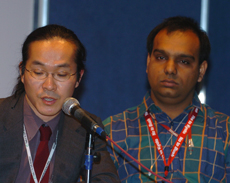 |
|
Sanjay Vashist, CAN International, and
Yuri Onodera, Friends of the
Earth-Japan, reviewed selected Annex I
and non-Annex I countries’ performances
in addressing climate change. They noted
that the EU ranked first as a result of,
inter alia, its leadership in
international climate negotiations and
its climate strategy, which includes the
Emissions Trading Scheme. |
|
Bill Hare, Greenpeace International,
described the impacts of climate
change and anticipated changes in
the climate system. He said
different types of risk call for
different measures, noting that
adaptation measures help communities
to cope with risk that cannot be
foreseen and addressed through
mitigation measures. He highlighted
the projected impacts of different
levels of warming on various
ecosystems, the ice cover, sea
levels and people, emphasizing that
millions of people are at risk of
malaria, water shortage and hunger
as a result of climate change. Hare
concluded that a 2°C warming
represents the level above which
millions of people and ecosystems
are at greater risk than at lower
temperatures. He stressed the need
for urgent action and policies,
noting that, if climate change
occurs as rapidly as predicted, the
greatest threats will be to poor
people in developing countries.
Sanjay Vashist, CAN International,
and Yuri Onodera, Friends of the
Earth-Japan, reviewed past
performances of selected countries
in addressing climate change. For
Annex I countries, Vashist said
criteria for assessment included: a
leadership role in international
climate negotiations; emission
trends and target fulfillment;
domestic policies; funding
commitments; and stated long-term
targets and initiatives to achieve
them. On this basis, he
|
|
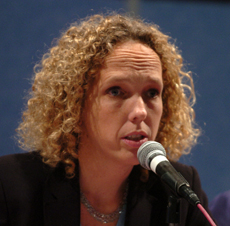 |
|
Noting that voluntary measures have not
proven efficient so far, Jennifer
Morgan, WWF International, stressed the
need for legally binding targets and
measures, and underscored the role of
developed countries in providing
assistance and resources to address
climate change. |
|
ranked the performance of the US,
Australia, Russia, Japan and the EU,
with the EU ranking first and the US
fifth. For non-Annex I countries,
Onodera said criteria included:
convention commitments; the status
of National Communications;
sustainable development policies;
emissions trends and forecast; and
their role in international
negotiations. He outlined the
reasons why South Africa, Mexico and
China all ranked second, while India
and Brazil ranked first.
Jennifer Morgan, World Wildlife Fund
for Nature (WWF) International,
presented options for a viable
global policy framework to address
climate change, noting that its
basic principles would include
equity, the historical
responsibility of industrialized
countries, ability to pay and
capacity to act, and the provision
of resources by industrialized
countries. She outlined a
three-track framework, including a
greening/decarbonisation track for
developing countries, an adaptation
track for most vulnerable countries,
and a Kyoto Protocol track. Morgan
explained criteria for moving from
one track to the other, highlighting
the level of effort in addressing
climate change, and stressed the
need for legally binding targets and
measures.
Discussion: Participants considered,
inter alia, the possible role of
financial institutions and the need
for a new financial framework, the
costs of
|
|
|
adaptation, and the capacity of
countries to benefit from the Clean
Development Mechanism (CDM). It was
noted that a shift in values is
needed to set up the necessary
framework, as well as large-scale
commitment from the public and
linkages with other issues, such as
desertification, deforestation,
disaster relief, and the energy
component of the Commission on
Sustainable Development process. |
|
Outcome of the workshop on the
preparation of the fourth national
communications by Annex I Parties
Presented by the UNFCCC Secretariat
|
|
|
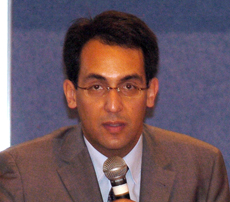 |
|
Harald Diaz-Bone, UNFCCC Secretariat,
noted that the guidelines indicate
policies and measures to be reported,
including those with the most
significant effects on GHG mitigation,
innovative policies that can be
effectively replicated by other parties,
and policies that are planned, adopted
and implemented. |
|
Daniela Stoycheva,
UNFCCC Subsidiary
Body for
Implementation,
introduced the
workshop on the
preparation of the
fourth national
communications by
Annex I Parties held
in Dublin, Ireland,
from 30 September to
1 October 2004. She
noted that the
workshop aimed to
strengthen Parties’
capacity to prepare
consistent and
comparable
information for
their
communications.
Vitaly Matsarski,
UNFCCC Secretariat,
said the workshop
addressed problems
encountered in the
preparation of
previous
communications, and
identified the need
to increase the
transparency and
comparability of
national
communications.
Harald Diaz-Bone,
UNFCCC Secretariat,
presented guidelines
for reporting
information in
national
communications,
highlighting
national
circumstances, GHG
emissions
inventories,
policies and
measures, and
projections
reflecting policies’
total effect as key
elements of the
communications. He
stressed the
importance of
consistency in
national
communications, and
noted that Parties
should report
policies with the |
|
most significant
effects on GHG mitigation,
those that may be
effectively replicated by
other Parties, and those
that are planned, adopted
and implemented. Diaz-Bone
said projections of future
trends in GHG emissions
should reflect two
scenarios, one including
policies’ mitigation effects
and one without.
Katia Simeonova, UNFCCC
Secretariat, stressed the
need to include the effects
of the main drivers of GHG
emission trends in national
communications. She called
for concise, complete and
transparent reporting, and
said Parties should use
consistent timelines when
estimating policy effects,
base estimates of policies’
contribution to mitigation
on robust baselines, and
include cost estimates. She
stressed the need to fully
explain methodology,
assumptions and key drivers.
Discussion: Participants
considered the range of
policies that should be
included in national
communications. Simeonova
indicated that data
reporting methods of
international organizations
may provide a useful model
and encourage consistency in
national communications.
|
|
|
Global Greenhouse Gas Register: Results
and new challenges
Presented by the World Economic Forum (WEF)
|
|
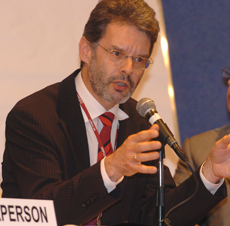 |
|
Bruno Vanderborght, Holcim, said current
CDM regulations are unacceptable to his
company because they are too detached
from business realities. |
|
Robert Casamento, Global Greenhouse
Gas Register, presented results and
new challenges of the Global
Greenhouse Gas Register, a
public-private partnership initiated
by the WEF. He outlined its main
areas of activity, namely disclosure
of corporate GHG inventories,
provision of a forum for dialogue,
and facilitation of the recognition
of member companies. He said the
register would encourage greater
corporate participation and
contribute to the understanding of
GHG reduction projects among
corporate members.
Bruno Vanderborght, Holcim, spoke on
GHG reporting and value creation. He
lamented the “no pain, no gain”
mindset within the CDM process,
which he said resulted in CDM
regulations that are disconnected
from reality. Noting that his
company had developed three CDM
projects that were not approved, he
said Holcim will stop participating
in the CDM as long as the rules are
not changed. He noted that current
regulations force project developers
to distort facts when writing CDM
Project Design Documents. He
emphasized that Holcim was committed
to developing
|
|
CDM projects based on clean
energy and creating value.
John Eyles, Alcoa, said his
aluminum producing company
joined the WEF registry to
show its commitment to
sustainability. He noted
that, from 2005 onwards,
Alcoa will implement a
management information
system that reports GHG
emissions of core areas on a
monthly basis.
Laurent Corbier, World
Business Council for
Sustainable Development (WBCSD),
outlined WBCSD’s reasons for
supporting the WEF registry,
including its integrated
stakeholder participatory
process, opportunities for
member companies to become
more visible, facilitation
of a sectoral approach, and
further involvement of
individual companies.
|
|
Climate change projection by the Earth
Simulator and related research outcomes
Presented by the Government of Japan
|
|
 |
|
Hiroki Kondo, FRCG/JAMSTEC, said
simulations indicate that the frequency
of tropical cyclones would decrease by
20% globally by the end of the 21st
Century, but their intensity would
increase. |
|
Toru Shigetomi, Japan Agency for
Marine-Earth Science and Technology
(JAMSTEC), outlined Japanese
research efforts regarding global
warming focusing on climate change
projection by the computer Earth
Simulator.
Hiroki Kondo, Frontier Research
Center for Global Change of Japan/JAMSTEC,
said Japanese research relied on
different global and regional
climate models, and comprised
several global warming simulations,
modeling of regional extreme weather
events and development of a model
that reflects the feedback effects
of climate change on GHG
concentrations. He said the results
will contribute to the fourth
assessment report of the IPCC.
Yoshiaki Nishimura, Central Research
Institute of Electric Power Industry
of Japan, emphasized that the
Japanese climate research assists in
defining the level to which GHG
emissions should be stabilized in
order to avoid dangerous
anthropogenic interference.
Matthew Collins, Hadley Center,
outlined collaboration between
Japanese and British climate
scientists, and elaborated on recent
climate change research in the UK.
|
Jose Marengo, Center for Weather
Forecasts and Climate Studies of
Brazil, indicated that, although
historically hurricanes have not
been known to occur in the South
Atlantic, “Catarina,” a tropical
cyclone or hurricane, affected
Southern Brazil in March 2004,
inflicting heavy damage. He
questioned whether this was an early
manifestation of the “surprise
weather” caused by climate change.
Shuzo Nishioka, National Institute
for Environmental Studies of Japan,
highlighted nationwide studies in
Japan, demonstrating that global
warming has significant impacts on
various industries, ecosystems and
human life. He emphasized that
avoiding a temperature rise of 2°C
would require strict GHG emission
controls.
|
|
Article 6 of the UNFCCC: Development of
a clearing house
Presented by the UNFCCC Secretariat
|
|
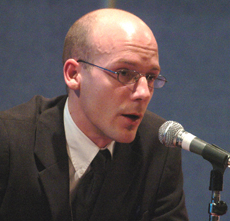 |
|
David Paterson, UNFCCC Secretariat,
discussed various systems for ranking
information, and explained how they
affect database search capabilities. |
|
Laurence Pollier, UNFCCC
Secretariat, discussed the
Secretariat’s mandate to develop an
information clearing house related
to UNFCCC Article 6 in order to
facilitate access to information and
enhance partnerships among
stakeholders. She said the criteria
for selecting a host organization
include its level of expertise,
links to the climate negotiations
process and ability to promote the
clearing house.
David Paterson, UNFCCC Secretariat,
presented a revised version of a
model providing an example of how a
clearing house can be integrated
with the UNFCCC website. He
demonstrated a number of technical
improvements aimed at enhancing
search functions and allowing for
the integration of multiple
languages. Paterson said the
submission of information would be
user friendly and would not require
high levels of computer expertise.
Discussion: In response to questions
from participants, Pollier stressed
that a clearing house does not exist
yet, that the model merely |
|
demonstrates a design option, and
that the present UNFCCC website’s
content management system would need
to be adapted to accommodate a
clearing house. Paterson clarified
that submitted information would be
stored until an administrator
examines and publishes it. One
participant drew attention to a
long-standing clearing house created
by the International Confederation
of Free Trade Unions. Several
participants asked whether business,
NGOs and other stakeholders can
submit information, and Pollier said
this issue needs to be considered by
Parties. Other participants
expressed concerns with property
rights, mechanisms for updating
information, funding for the
clearing house, and control of the
quality of information. Pollier
noted that funding would be on a
voluntary basis, and said US$280
thousand was needed. |
|
Sustainable development policies and
measures for climate protection
Presented by the World Resources
Institute (WRI)
|
|
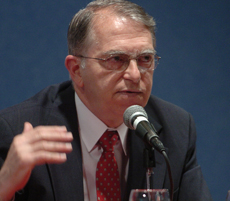 |
|
José Roberto Moreira, CENBIO National
Center of Biomass, described how
increases in ethanol generation has
resulted in job creation in Brazil. |
|
Rob Bradley, WRI, noted that while
the participation of developing
countries in the climate regime is
essential, they have other
priorities. He stressed the need for
sustainable development polices and
measures (SD-PAMS) that incorporate
climate priorities in strategies for
sustainable development.
Tim Herzog, WRI, introduced the
Climate Analysis Indicators Tool (CAIT),
which consists of a package of
indicators relevant to climate
change, including inventories of GHG
emissions by country, sector, gas
and year. He explained how the CAIT
can be used to analyze data on GHG
emissions.
José Roberto Moreira, CENBIO
National Center of Biomass,
identified key factors in the
successful diffusion of ethanol use
in Brazil, including: achievement of
energy security; availability of
lands for sugar cultivation;
appropriate business climate; job
creation benefits; and low labor
costs. |
|
Wei-Shiuen Ng, EMBARQ/WRI Center for
Transport and the Envrionment,
introduced a case study measuring
the impact of advanced technology on
transport energy use in China. She
indicated that the transport sector
was responsible for 32.8% of total
energy consumption in 2000, an
amount that is predicted to increase
to 87.3% by 2030. She noted that the
case study aims to investigate two
scenarios, where technologies
including hybrids, compressed
natural gas and electric cars
achieve different levels of market
penetration.
Bradley presented a study on the
provision of electricity in India,
noting that 700 million Indians do
not have access to reliable
electricity. He stressed that the
expansion of India’s power sector
represents a window of opportunity
to generate a development leap in
electricity provision, without
increasing coal dependency.
Stanford Mwakasonda, University of
Cape Town, outlined a study on
carbon capture and storage in South
Africa, noting that the country is
the largest GHG emitter in Africa
due to the size of its economy and
reliance on coal for 93% of
electricity generation. He indicated
that 12% of South Africa’s total
carbon dioxide emissions could be
captured, transported and stored for
US$70/ton carbon dioxide. He said
carbon capture delivers low
sustainable development benefits to
local communities.
Discussion: Participants expressed
concern regarding the case studies’
emphasis on the resource aspect of
development at the cost of the
social aspect, suggested that a more
participatory research process could
better reveal social priorities, and
urged the inclusion of a broader
sustainable development agenda in
the studies. |
|
Business perspectives on a long-term
international policy approach
Presented by the International Chamber
of Commerce (ICC)
|
|
 |
|
José Romero, Swiss Agency for the
Environment, Forests and Landscape, said
the paper presented by the ICC shows
that business is a socially responsible
actor. |
|
Norine Kennedy, US Council for
International Business, said the ICC
represents over 7000 member
companies from around the world and
that their paper on long-term
international climate policy was
drafted through a democratic
consensus-building process.
Brian Flannery, Exxon Mobil
Corporation, emphasized that the
challenge is to meet the rising
demand for energy, while responding
to climate change concerns and
regulations. He said the Kyoto
Protocol provides certainty for
upcoming negotiations regarding the
post 2012 period, but uncertainty
regarding the process to come.
Masayuki Sasanouchi, Toyota Motor
Corporation, outlined the
challenges, which negotiators will
face when discussing the second
commitment period, and stressed the
importance of new technologies for
addressing the foreseen emissions
growth in developing countries.
Nick Campbell, ICC, highlighted the
need for universal participation in
the |
|
climate regime and the role of
technology, and questioned whether
the current scheme will deliver
long-term benefits. He said the ICC
encourages voluntary actions and
promotes global participation,
market incentives, and scientific
research for new energy
technologies.
Drew Clarke, Australian Department
of Industry, Tourism and Resources,
commented on the paper by
identifying three main issues:
recognition of the climate change
problem; the need to involve all
Parties; and the major role of
technology in addressing climate
change.
José Romero, Swiss Agency for the
Environment, Forests and Landscape,
commended the business sector for
supporting and contributing to the
UNFCCC process. He said a vision and
a clear framework for business are
needed.
Hiroshi Yamagata, Japan’s Ministry
of Economy, Trade and Industry,
listed difficulties in designing
research and development programmes
that are successful in the long
term. He stressed the importance of
incentives, and called for changes
to the CDM process to make it more
attractive.
Harlan Watson, US Department of
State, concurred with the paper’s
emphasis on technology, voluntary
actions and market solutions.
Discussion: Several participants
expressed disappointment with the
ICC paper, lamenting what they
described as vague and undermining
language, the failure to accept
legally binding caps, and the
ignorance of renewable energy
technologies. |
Dispute settlement in flexible mechanism
contracts
Presented by the Permanent Court of
Arbitration (PCA)
|
 |
|
Stefan Raubenheimer emphasized that the
parties to an emissions reduction
purchase agreement must carefully choose
the law applicable to the substance of
the contract and possible arbitration
proceedings. |
|
Dane Ratliff, PCA, indicated that
CDM projects could give rise to
disputes involving only States, or
disputes involving States and
private parties. He highlighted the
benefits of arbitration in solving
disputes concerning flexibility
mechanism contracts, and said some
bilateral investment treaties
provide arbitration clauses for CDM
projects’ investors.
Werner Grau Nero, Pinhero Neto
Advogados, noted that the Brazilian
CDM process is complicated by the
slow approval process and
uncertainties concerning
sustainability criteria. He
indicated that the judicial system
is inefficient, and emphasized
arbitration as the best dispute
settlement method for Brazilian CDM
projects.
Stefan Raubenheimer, SouthSouthNorth,
said CDM contracts are often drafted
by Northern buyers, and highlighted
the importance of educating Southern
participants about best dispute
settlement methods. He said defining
the contribution of a CDM project to
sustainable development is a
complicated task in which discretion |
|
|
belongs to the Designated National
Authority (DNA). He said this
presents a risk to private parties,
since it could lead to a judicial
review of the DNA’s administrative
decision.
Chester Brown, Clifford Chance,
listed sovereign immunity and
inconsistencies in legal remedies as
current uncertainties surrounding
the EU’s Emissions Trading Scheme,
and said the legal characterization
of the emission allowances affects
their treatment under tax and
insolvency laws. He noted that there
are three model contracts that
entail different legal consequences
when a party fails to deliver the
contracted emission reductions. He
stressed arbitration as the best
dispute settlement option, said
parties to a contract must choose
between ad hoc or institutional
arbitration, and outlined the
enforcement of arbitral awards.
Discussion: Participants questioned
the competence of the CDM Executive
Board to impose conditions on the
Letter of Approval other than those
specified in the Marrakesh Accords.
Ratliff noted that the legal
responsibility of an Annex I Party
authorizing a private entity to
participate in a CDM project is an
open question, likely to be dealt
with through national courts.
Participants highlighted the
interests of local communities in
CDM projects, and said the issue
merits special attention. Ratliff
said the withdrawal of a host
country from the Kyoto Protocol
would not necessarily mean that CDM
projects in that country would cease
realizing Certified Emission
Reductions. |
|
|
|







